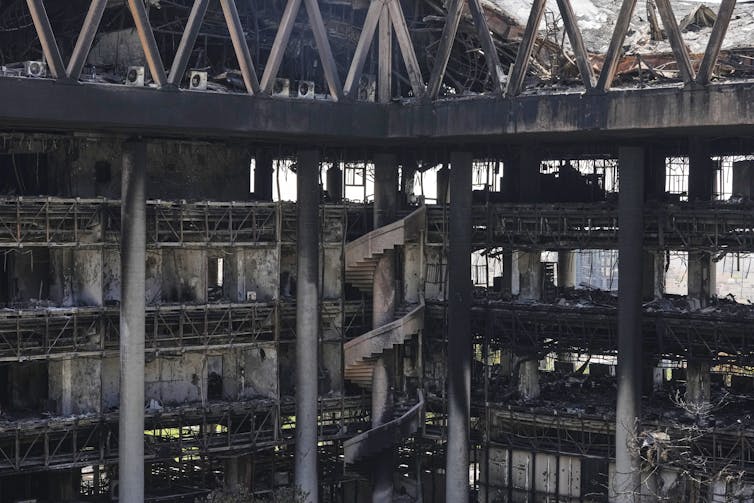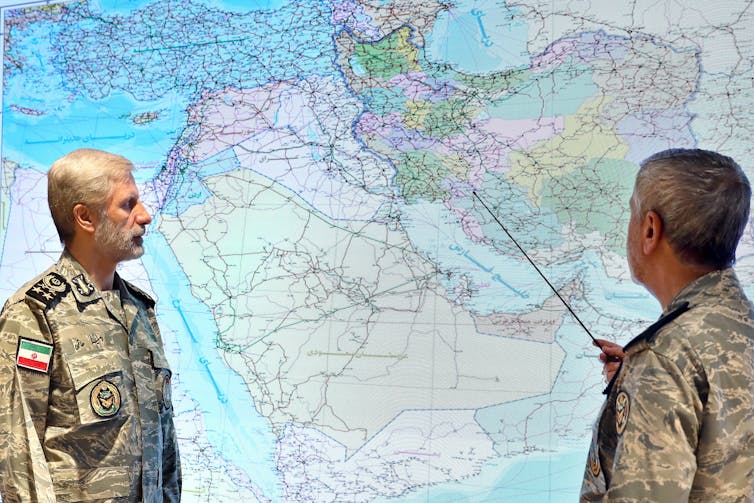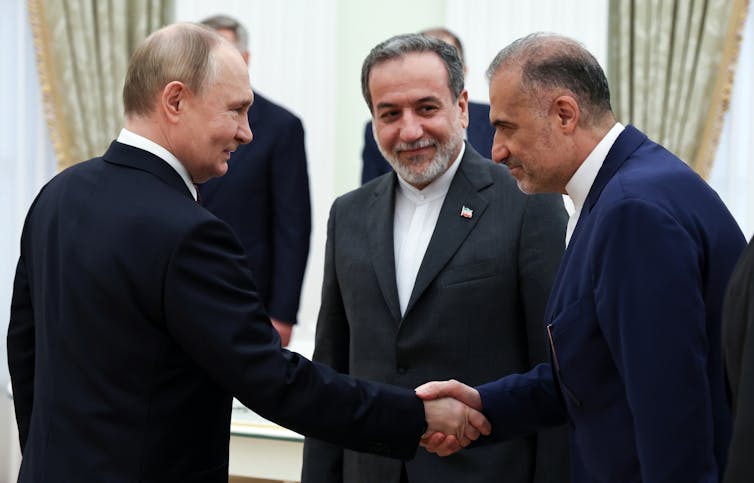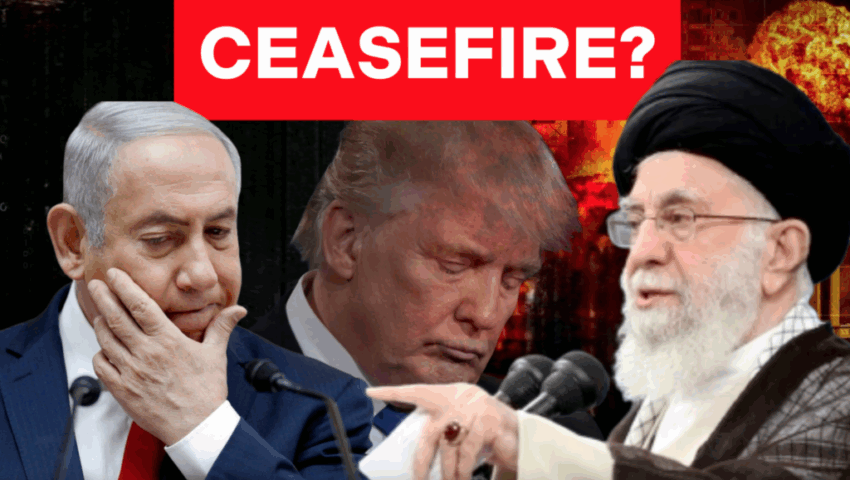Iran and Israel are said to have reached an agreement for a ceasefire after 12 days of intense air strikes, which included a “last-minute” barrage launched by Tehran. On Tuesday morning, Prime Minister Benjamin Netanyahu stated that Israel had accepted the truce proposal put forth by United States President Donald Trump the previous night. The Iranian state television had reported that the ceasefire is now in effect.
The Economic Times reported that a representative from the central command headquarters of the Iranian armed forces has alleged that Israel conducted strikes against Iran until 9 a.m. local time. Iran responded in kind and launched a last salvo of Missiles hitting the city of Beersheba in the Negev. From what we can tell, the ceasefire between Iran and Israel was implemented just moments after Tehran and Tel Aviv engaged in their final exchange of fire. In the meantime, Israel’s Minister of Military Affairs, Israel Katz, asserted that Iran breached the ceasefire and commanded “intense strikes” against Iran. This assertion was quickly refuted by multiple Iranian media outlets and the Islamic Revolution Guards Corps (IRGC). Gabby Sobelman, reporting from Beersheba for The NewYork Times, wrote:
“At least four people were killed in southern Israel when a ballistic missile fired from Iran hit an apartment block in the hours before the two countries confirmed that they had agreed to a cease-fire on Tuesday, according to the Israeli authorities.”
NYT Video confirms that “the Iranian Strike (on Beersheba) came in the last hours before Israel and Iran agreed to a ceasefire”… and not after the ceasefire was agreed upon by both sides. Iran did not violate the ceasefire as Israeli Defense Minister Katz would have you… pic.twitter.com/tgqk1fhlhf
— Freddie Ponton (@freddie_ponton) June 24, 2025
Furthermore, IRGC chief commander, Major General Mohammad Pakpour, has issued a warning to the United States, stating that any resurgence of aggression towards Iran would lead the Islamic Republic to impart a “historic lesson” to Washington. Iran’s symbolic attack on the al-Udeid air base in Qatar — the largest American military installation in West Asia — resulted in no significant damages or repercussions, and the Americans, who had received warnings ahead of the assault, do not plan to retaliate. Initially, Trump wanted Iran to be the first to exit the conflict, and after a 12-hour ceasefire, Israel would participate, culminating in “an Official End of the 12 Days War”. It is evident that Trump’s choreography did not unfold as intended, and that both Israel and Iran sought to engage with one another to establish a ceasefire on what could be promoted as a positive note.
Many are questioning the fragility of this ceasefire and its ability to hold. The Conversation has the story…
VIDEO: Donald Trump on Iran-Israel Ceasefire (Source: The Guardian)
.
Ali Mamouri reports for The Conversation…
Iran and Israel agree to a fragile ceasefire. One factor could be crucial to it sticking
After 12 days of war, US President Donald Trump has announced a ceasefire between Israel and Iran that would bring to an end the most dramatic, direct conflict between the two nations in decades.
Israel and Iran both agreed to adhere to the ceasefire, though they said they would respond with force to any breach.
If the ceasefire holds – a big if – the key question will be whether this signals the start of lasting peace, or merely a brief pause before renewed conflict.
As contemporary war studies show, peace tends to endure under one of two conditions: either the total defeat of one side or the establishment of mutual deterrence. This means both parties refrain from aggression because the expected costs of retaliation far outweigh any potential gains.
What did each side gain?
The war marked a turning point for Israel in its decades-long confrontation with Iran. For the first time, Israel successfully brought a prolonged battle to Iranian soil, shifting the conflict from confrontations with Iranian-backed proxy militant groups to direct strikes on Iran itself.
This was made possible largely due to Israel’s success over the past two years in weakening Iran’s regional proxy network, particularly Hezbollah in Lebanon and Shiite militias in Syria.
Over the past two weeks, Israel has inflicted significant damage on Iran’s military and scientific elite, killing several high-ranking commanders and nuclear scientists. The civilian toll was also high.

IMAGE: The damaged headquarters of Iran’s state television Headquarters in Tehran (Source: Vahid Salemi/AP)
Additionally, Israel achieved a major strategic objective by pulling the United States directly into the conflict. In coordination with Israel, the US launched strikes on three of Iran’s primary nuclear facilities: Fordow, Natanz and Isfahan.
Despite these gains, Israel did not accomplish all of its stated goals. Prime Minister Benjamin Netanyahu had voiced support for regime change, urging Iranians to rise up against Supreme Leader Ali Khamenei’s government, but the senior leadership in Iran remains intact.
Additionally, Israel did not fully eliminate Iran’s missile program, as Iran continued striking to the last minute before the ceasefire. And Tehran did not acquiesce to Trump’s pre-war demand to end uranium enrichment.
Although Iran was caught off-guard by Israel’s attacks — particularly as it was engaged in nuclear negotiations with the US — it responded by launching hundreds of missiles towards Israel. While many were intercepted, a significant number penetrated Israeli air defences, causing widespread destruction in major cities, dozens of fatalities and hundreds of injuries.

IMAGE: The commander-in-chief of the Iranian Army, Amir Hatami (left), attends a meeting in the Iranian Army’s War Command Room in an unknown location. (Source: Iranian Army Media Office/EPA)
Iran demonstrated its capacity to strike back, though Israel succeeded in destroying many of its air defence systems, some ballistic missile assets (including missile launchers) and multiple energy facilities. (…)
As theories of victory suggest, success in war is defined not only by the damage inflicted but by achieving core strategic goals and weakening the enemy’s will and capacity to resist.
While Israel claims to have achieved the bulk of its objectives, the extent of the damage to Iran’s nuclear program is not fully known, nor is its capacity to continue enriching uranium.
Both sides could remain locked in a volatile standoff over Iran’s nuclear program, with the conflict potentially reigniting whenever either side perceives a strategic opportunity.
Sticking point over Iran’s nuclear program
Iran faces even greater challenges as it emerges from the war. With a heavy toll on its leadership and nuclear infrastructure, Tehran will likely prioritise rebuilding its deterrence capability.
That includes acquiring new advanced air defence systems — potentially from China — and restoring key components of its missile and nuclear programs. (Some experts say Iran did not use some of its most powerful missiles to maintain this deterrence.)
Iranian officials have claimed they safeguarded more than 400 kilograms of 60% enriched uranium before the attacks. This stockpile could theoretically be converted into nine to ten nuclear warheads if further enriched to 90% (or transferred to Russia for safekeeping…)
Trump declared Iran’s nuclear capacity had been “totally obliterated”, whereas Rafael Grossi, the United Nations’ nuclear watchdog chief, said damage to Iran’s facilities was “very significant”. However, analysts have argued Iran will still have a depth of technical knowledge accumulated over decades. Depending on the extent of the damage to its underground facilities, Iran could be capable of restoring and even accelerating its program in a relatively short time frame. The chances of reviving negotiations on Iran’s nuclear program appear slimmer than ever.
What might future deterrence look like?
The war has fundamentally reshaped how both Iran and Israel perceive deterrence — and how they plan to secure it going forward.
For Iran, the conflict reinforced the belief that its survival is at stake. With regime change openly discussed during the war, Iran’s leaders appear more convinced than ever that true deterrence requires two key pillars: nuclear weapons capability and deeper strategic alignment with China and Russia.
As a result, Iran is expected to move rapidly to restore and advance its nuclear program, potentially moving towards actual weaponisation — a step it had long avoided, officially. At the same time, Tehran is likely to accelerate military and economic cooperation with Beijing and Moscow to hedge against isolation. Iranian Foreign Minister Abbas Araghchi emphasised this close engagement with Russia during a visit to Moscow this week, particularly on nuclear matters.

IMAGE: Russian President Vladimir Putin (left) shakes hands with Iran’s ambassador to Russia, Kazem Jalali, as Iranian Foreign Minister Abbas Araghchi (centre) looks on during their meeting at the Kremlin (Source: Sputnik pool/EPA)
Israel, meanwhile, sees deterrence as requiring constant vigilance and a credible threat of overwhelming retaliation. In the absence of diplomatic breakthroughs, Israel may adopt a policy of immediate preemptive strikes on Iranian facilities or leadership figures if it detects any new escalation — particularly related to Iran’s nuclear program.
In this context, the current ceasefire appears fragile. Without comprehensive negotiations that address the core issues — namely, Iran’s nuclear capabilities — the pause in hostilities may prove temporary.
Mutual deterrence may prevent a more protracted war for now, but the balance remains precarious and could collapse with little warning.
See more news from The Conversation
READ MORE IRAN NEWS AT: 21st Century Wire IRAN Files
SUPPORT OUR INDEPENDENT MEDIA PLATFORM – BECOME A MEMBER @21WIRE.TV
VISIT OUR TELEGRAM CHANNEL
Click this link for the original source of this article.
Author: Global Affairs
This content is courtesy of, and owned and copyrighted by, https://21stcenturywire.com and its author. This content is made available by use of the public RSS feed offered by the host site and is used for educational purposes only. If you are the author or represent the host site and would like this content removed now and in the future, please contact USSANews.com using the email address in the Contact page found in the website menu.








